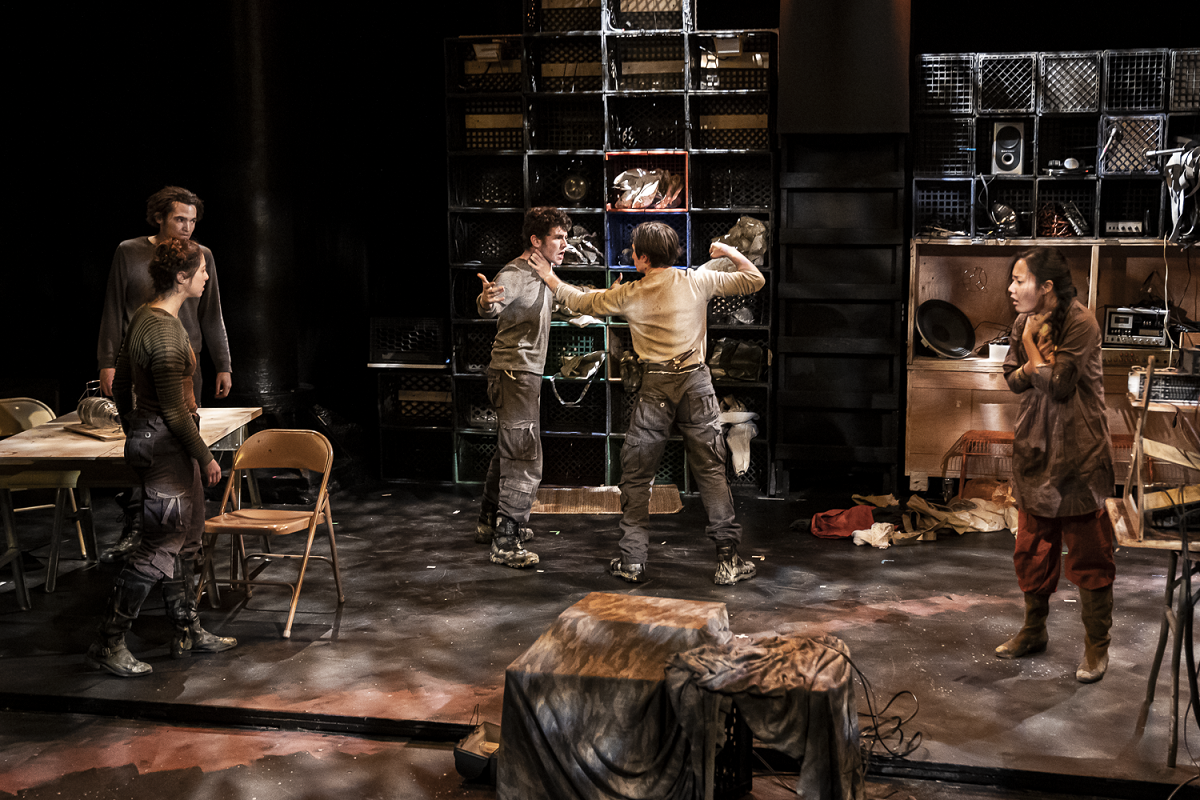
The Listening Room
Written by Michaela Jeffery
Directed by Ivette Dumeng and Lori Kee
Presented by Nylon Fusion Theatre Company at The New Ohio Theatre, NYC
November 30-December 21, 2019
Characters in the work of Samuel Beckett often tell their stories as a way of proving or leaving a record that they existed. Michaela Jeffery's The Listening Room expands such concerns to an entire civilization, limning dystopia on an epic scale through the intense interactions of a handful of characters who occupy the titular, bunker-like room. Making its New York premiere in repertory with another science-fiction play, Steven Mark Tenney's ray gun sayOnara, at The New Ohio Theatre, The Listening Room explores the weaponization of information, history, narrative, and memory alongside the potentiality of dissent, resistance, and revolution, resonating, as much good speculative fiction does, both with and beyond our present moment.
Civilization in The Listening Room is concentrated in the Earie -- originally founded, according to its own origin myths and prior to "the Collapse," as a better alternative to a self-destructive society -- is surrounded by nothing but desert for, as one character claims, thousands of miles and is ruled by the Council. The Listening Room is located miles from the Earie, and the teenaged Listeners who live there are tasked with listening to and sending written reports to the Council on fragments of transmissions picked up by large dishes called "ears." While the Council no longer authorizes new Listeners, a young blind girl named Isobel (Sara Rahman) arrives at the Listening Room from the Earie, where she is discovered by Fayette (Matthew Carrasco), who tries to force her to leave. She claims to have been invited to become a Listener by Marcus (Tim Palmer), the most vocal anti-Council advocate among the group, which also includes Rouke (Taylor Petracek) and Lanolin (Alex Chernin), who acts as the Recorder (much of the population of the Earie is illiterate, the better, as Marcus tells it, to keep them subjugated). There is skepticism among the Listeners (and would-be Listener Isobel) that they are indeed living in an era of unprecedented freedom, as their government asserts. When Marcus is summoned to answer an accusation of criminality, it forces this group of young people into an accelerated decision about whether they will take action.
The Listeners' conflicts, which occasionally turn physical in well-choreographed fights that also underscore the characters' youth, weave together a range of thematic considerations, from choice and self-determination (including the dispensation granted to Listeners to choose new names for themselves) to the manipulation of public perception and, thus, behavior, including in legal matters (exiling a minor, for instance, is more palatable than executing one) and particularly through the use of fear and the foregrounding of nebulous threats (this should all sound very familiar), as well as the preservation and significance of individual, social, and even cosmic histories. The set design, by Raye Lavine, is fantastic, with its ladder to the surface, wall of cubbies, and jumble of electronic equipment; and its atmosphere is augmented by excellent lighting that makes use of blues, oranges, and reds and sound design that includes a constant low background hum. Palmer and Chernin stand out among a strong cast, with Carrasco and Petracek providing contrasting foils to Palmer's cocky, idealistic Marcus and Rahman doing convincing work with both Isobel's visual impairment and her quietly fiery determination.
The Listening Room depicts a world in which a person's value corresponds to their contribution and their conformity, and in which an omnipresent sense of threat hinders mobilization for change. While Rouke may have a point when he argues that while anyone can smash things, it's also necessary to have a plan for what comes next, Marcus makes the equally valid point that it is far too easy to justify continued inaction, that masses of individuals going about their daily routines merely reinforces stasis in the end. In the play, stories are records of the past that can point the way to the future, and what we listen for and how we interpret and (re)present what we hear determines what kind of future that will be. The Listening Room itself is one such story, and it is well worth lending it your ears (and eyes). - Leah Richards & John Ziegler

Thank you for the review !! Pls credit only myself - raye levine - for set! Lili Jaxon did the props :) thank you!